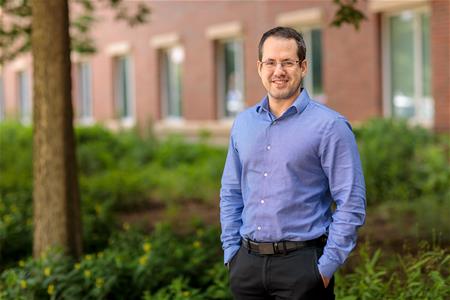Sep 16, 2019
Duarte combining machine learning with finance
Victor Duarte couldn’t be happier to land at Gies College of Business. The new assistant professor in the Department of Finance has a passion for directing the future of finance using machine learning. It’s a research subject that fits perfectly into Gies’ commitment to innovation and faculty excellence.
 “Leadership at Gies College of Business truly values the type of research I do,” said Duarte. “Connecting cutting-edge machine learning techniques with finance isn’t appreciated everywhere, and here the reception has been great. At Gies, I have a lot of colleagues with whom I can discuss my research, and I wouldn’t have that ability at many other places.”
“Leadership at Gies College of Business truly values the type of research I do,” said Duarte. “Connecting cutting-edge machine learning techniques with finance isn’t appreciated everywhere, and here the reception has been great. At Gies, I have a lot of colleagues with whom I can discuss my research, and I wouldn’t have that ability at many other places.”
That starts with an existing relationship Duarte has with Gies Business professor Dejanir Silva. The two Brazilians completed their PhDs at MIT together and teamed up to co-author a paper, “Firm Leverage and the Transmission of Consumer Demand Shocks.” Before earning his PhD, Duarte completed a bachelor’s in aeronautical engineering and a master’s in economics. For the last year, Duarte has delved even deeper into his machine learning research as a research economist at the Federal Reserve Bank of Dallas.
“I strongly believe we should adopt more machine learning and use it to advance our fields,” he said. “There are many problems in finance that are very difficult to solve using traditional methods, but machine learning helps you discover new patterns in the data. It helps you do some forecasting and helps solve very complicated, dynamic problems.”
Duarte points to investors trying to choose the right portfolio, addressing the age-old finance question, “Where do I invest?” Typically investors choose stocks and bonds, neglecting to maximize the vast flexibility in investment choices like the housing market, foreign exchange rates, and foreign equities. Duarte’s research shows that employing simulations and data through machine learning can direct investors toward better ways to hedge risk and make more optimal decisions.
“The answers we have today are not very good. We have to simplify a lot to give a precise answer,” he said. “There’s a wealth of financial instruments you could use to maximize your welfare. Machine learning offers you the possibility of addressing these questions. You don’t have to rely on a very simplified model of the world to arrive at a good investment strategy. You can now use data and simulations to arrive at a better outcome.”
These are the types of tangible applications Duarte hopes to communicate to his students. He currently teaches a machine learning course for graduate students, mostly in the master’s in finance and master’s in financial engineering programs.
“I’m trying to show them real examples of interesting machine learning applications to show them how enjoyable it can be. If you have a business idea, employing machine learning tools can make it easier to succeed.”


